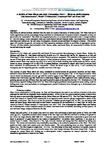A review of bast fibres and their composites. Part 1 - Fibres as reinforcements
| dc.contributor.author | Summerscales, John | |
| dc.contributor.author | Dissanayake, NPJ | |
| dc.contributor.author | Virk, AS | |
| dc.contributor.author | Hall, W | |
| dc.date.accessioned | 2017-09-14T13:46:37Z | |
| dc.date.available | 2017-09-14T13:46:37Z | |
| dc.date.issued | 2010-10 | |
| dc.identifier.issn | 1359-835X | |
| dc.identifier.issn | 1878-5840 | |
| dc.identifier.uri | http://hdl.handle.net/10026.1/9928 | |
| dc.description.abstract |
Bast fibres are defined as those obtained from the outer cell layers of the stems of various plants. The fibres find use in textile applications and are increasingly being considered as reinforcements for polymer-matrix composites as they are perceived to be "sustainable". The fibres are composed primarily of cellulose which potentially has a Young's modulus of similar to 140 GPa (being a value comparable with man-made aramid [Kevlar/Twaron] fibres). The plants which are currently attracting most interest are flax and hemp (in temperate climates) or jute and kenaf (in tropical climates). This review paper will consider the growth, harvesting and fibre separation techniques suitable to yield fibre of appropriate quality. The text will then address characterisation of the fibre as, unlike man-made fibres, the cross section is neither circular nor uniform along the length. (c) 2010 Elsevier Ltd. All rights reserved. | |
| dc.format.extent | 1329-1335 | |
| dc.language | EN | |
| dc.language.iso | EN | |
| dc.publisher | ELSEVIER SCI LTD | |
| dc.subject | Natural fibres | |
| dc.subject | Fibres | |
| dc.subject | URTICA-DIOICA L | |
| dc.subject | NATURAL FIBERS | |
| dc.subject | POLYMER COMPOSITES | |
| dc.subject | TENSILE PROPERTIES | |
| dc.subject | POLYESTER RESIN | |
| dc.subject | FINE-STRUCTURE | |
| dc.subject | NETTLE FIBERS | |
| dc.subject | FLAX FIBERS | |
| dc.subject | JUTE | |
| dc.subject | STRENGTH | |
| dc.title | A review of bast fibres and their composites. Part 1 - Fibres as reinforcements | |
| dc.type | journal-article | |
| dc.type | Review | |
| plymouth.author-url | https://www.webofscience.com/api/gateway?GWVersion=2&SrcApp=PARTNER_APP&SrcAuth=LinksAMR&KeyUT=WOS:000281945800001&DestLinkType=FullRecord&DestApp=ALL_WOS&UsrCustomerID=11bb513d99f797142bcfeffcc58ea008 | |
| plymouth.issue | 10 | |
| plymouth.volume | 41 | |
| plymouth.publication-status | Published | |
| plymouth.journal | Composites Part A: Applied Science and Manufacturing | |
| dc.identifier.doi | 10.1016/j.compositesa.2010.06.001 | |
| plymouth.organisational-group | /Plymouth | |
| plymouth.organisational-group | /Plymouth/Faculty of Science and Engineering | |
| plymouth.organisational-group | /Plymouth/Faculty of Science and Engineering/School of Engineering, Computing and Mathematics | |
| plymouth.organisational-group | /Plymouth/REF 2021 Researchers by UoA | |
| plymouth.organisational-group | /Plymouth/REF 2021 Researchers by UoA/UoA12 Engineering | |
| plymouth.organisational-group | /Plymouth/Research Groups | |
| plymouth.organisational-group | /Plymouth/Research Groups/Marine Institute | |
| plymouth.organisational-group | /Plymouth/Users by role | |
| plymouth.organisational-group | /Plymouth/Users by role/Academics | |
| dc.identifier.eissn | 1878-5840 | |
| dc.rights.embargoperiod | No embargo | |
| rioxxterms.versionofrecord | 10.1016/j.compositesa.2010.06.001 | |
| rioxxterms.licenseref.uri | http://www.rioxx.net/licenses/all-rights-reserved | |
| rioxxterms.type | Journal Article/Review |


